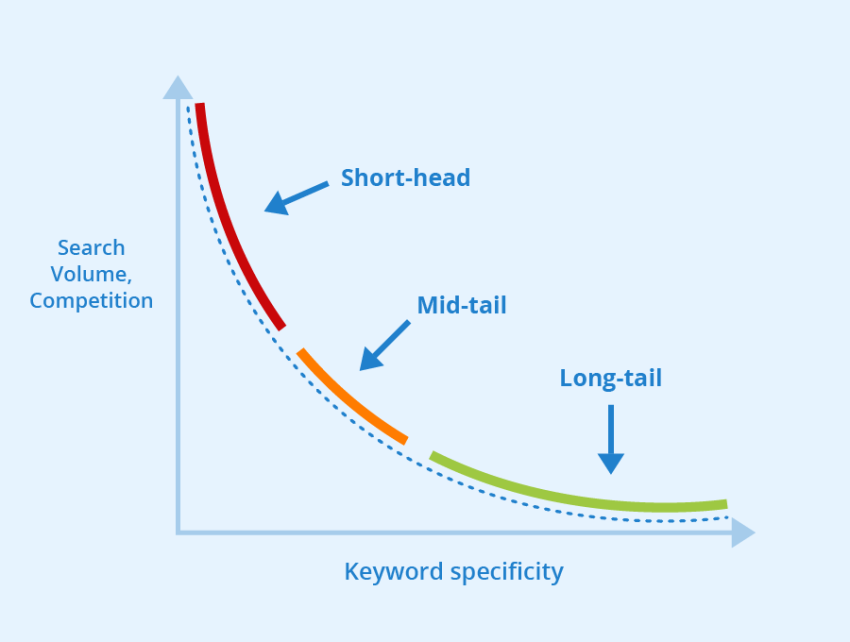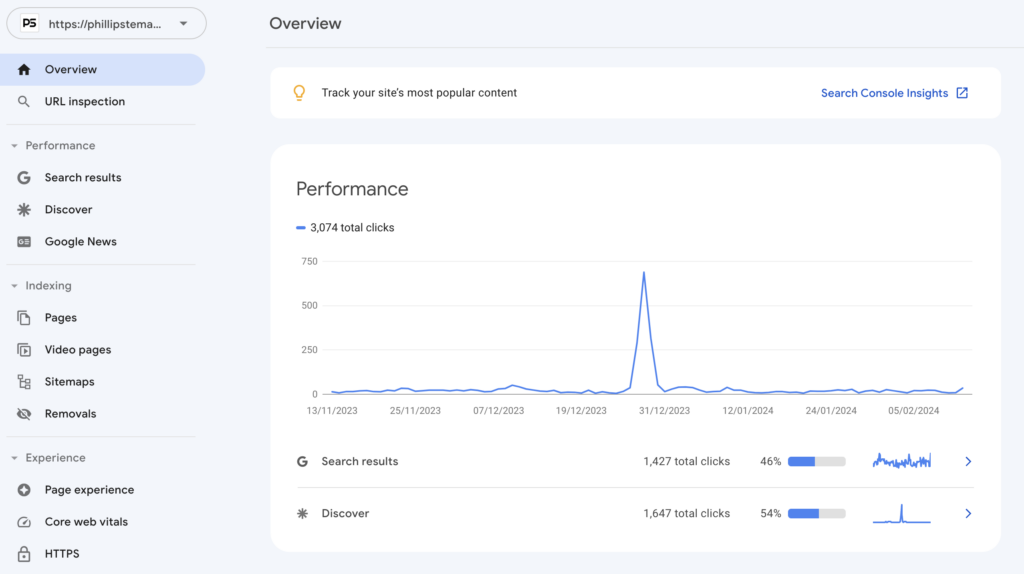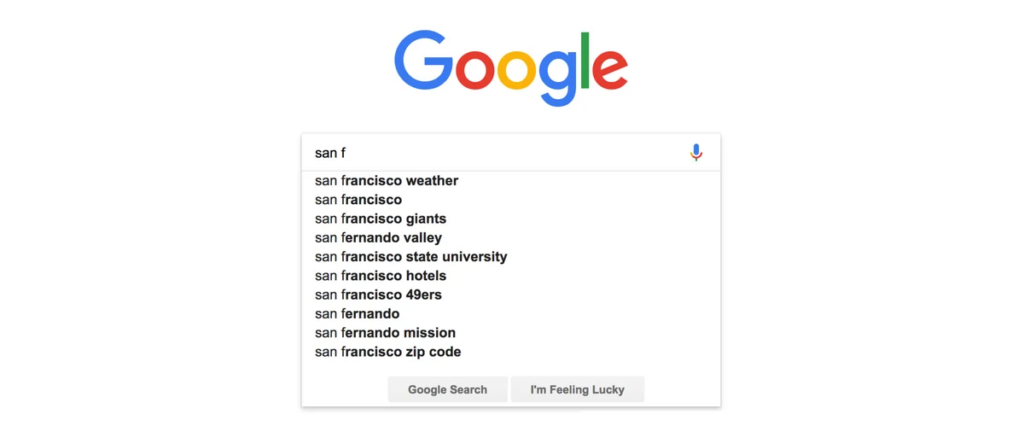In digital marketing, mastering the use of keywords in SEO is crucial for success. Short-tail keywords, often referred to as “head terms,” are typically 1-3 words in length and are known for the high volume of traffic they can generate.
However, the competition for short-tail keywords is equally significant, often making it challenging for pages to rank on search engine results pages (SERPs). On the other hand, ” long-tail” keywords are longer words and phrases that are more specific than their short-tail counterparts.
While examples of long-tail keywords might not bring the same volume of traffic, they tend to have less competition, making it easier for niche content to rank. Each keyword is a phrase that can precisely match the queries of target users, catering to their specific pain points.
What Is a Short Tail Keyword?
Short-tail keywords are the cornerstone of SEO content. They are generally composed of 1-3 words and embody broad search queries with high traffic potential.
Short-tail keywords are generic, often used by individuals at the beginning of their search process, and represent a wide array of user intents. Due to their broad nature, short-tail keywords can be highly competitive.
Businesses across various industries vie to rank for short-tail keywords, which can drive substantial website traffic. These keywords often serve as the foundation for an SEO strategy, encapsulating the primary themes of a website’s content.
However, the brevity of short-tail keywords can sometimes be a disadvantage. The vagueness of such terms can lead to a mismatch between the content and the searcher’s intent.
This may result in a lower conversion rate, as visitors might not find exactly what they were searching for. Moreover, the high keyword difficulty associated with short-tail terms makes it challenging for new or less authoritative sites to make a mark.
Without a robust SEO foundation and a significant investment in content and link-building efforts, the chances of ranking for these terms are slim.
Pros
- Short-tail keywords are valuable in digital marketing because of their potential to attract a large traffic volume.
- They serve as broad indicators of content themes and can significantly enhance a site’s visibility.
- When a site does manage to rank for these terms, it can benefit from increased exposure and recognition in its industry.
Cons
- Despite their potential, short-tail keywords come with considerable drawbacks.
- The intense competition for these terms means that only the most authoritative websites will likely secure top positions.
- Furthermore, these keywords can lead to high bounce rates if the content does not align closely with user expectations.
- Additionally, the generic nature of short-tail keywords may not capture users’ specific intent, which can result in less targeted traffic and lower engagement.
- This lack of specificity often translates into a lower return on investment for businesses that solely focus on these terms in their SEO efforts.
What Is a Long Tail Keyword?
Long-tail keywords are more descriptive phrases that often contain more than three words. They are tailored to match users’ specific search queries and indicate a clearer intent.
These keywords cater to users further in the buying or research process, providing more detailed results. Since long-tail keywords are more specific, they typically face less competition and can make it easier for pages to rank on SERPs.
This specificity allows businesses to target niche markets and connect with users who are more likely to convert into customers. Long-tail keywords are integral to creating SEO content that addresses a target audience’s detailed concerns and questions.
While these keywords may attract less traffic than short-tail, the traffic is often more targeted and engaged. This can lead to higher conversion rates, as users reaching the site through long-tail searches usually seek specific information or products.
Pros
- Long-tail keywords are beneficial because they can attract a more targeted audience with a higher likelihood of conversion.
- They help businesses rank in specific niches, reducing the competition typically seen with short-tail keywords.
- This specificity aligns with user intent, creating a more satisfying user experience.
- Additionally, long-tail keywords can be a strategic asset for new or smaller websites.
- They offer these sites an opportunity to establish a foothold in the SERPs by targeting terms that are within reach and relevant to their unique offerings.
Cons
- One of the limitations of long-tail keywords is the lower volume of traffic they attract compared to short-tail keywords.
- For businesses seeking large-scale visibility, relying solely on long-tail keywords may not suffice.
- Furthermore, the highly specific nature of these terms can limit the breadth of the audience reached.
- Another challenge with long-tail keywords is the need for more content.
- A business must produce a substantial amount of detailed and varied content, which can be resource-intensive, to target a wide range of long-tail phrases effectively.
Why Are Both Types of Keywords Important?
Short and long-tail SEO keywords are vital components of a comprehensive SEO strategy. Short-tail keywords offer the potential for high traffic volume and brand visibility, while long-tail keywords provide targeted traffic with a higher conversion potential.
Integrating both types allows for a diversified approach to SEO, capturing a wide audience while honoring specific customer segments. For instance, a law firm might target short-tail keywords like “lawyer” to gain broad exposure. It also utilizes long-tail keywords like “personal injury attorney in Miami” to attract clients with specific legal needs in their region.
This dual approach can enhance the firm’s online presence across different customer journey stages. Ultimately, the importance of using both keywords lies in balancing broad reach with precision targeting.
This balance enables businesses to maximize their online potential, drawing in general and niche markets to support various business objectives, from brand awareness to lead generation.
How to Balance Between Short-Term and Long-Term Keywords?
Balancing between short-tail and long-tail keywords is essential for maximizing organic traffic. Due to their generic nature and brevity, short-tail keywords often have higher volume and competition but provide less targeted traffic.
Conversely, while less competitive, long-tail keywords offer the chance to connect with users on specific pain points. One strategy to achieve this balance is to use short-tail keywords for broad topics and categories while employing long-tail keywords for specific pages and articles.
This approach allows the highly competitive short-tail keywords to serve as pillars for the site’s content structure, while the detailed long-tail keywords target users with specific interests or questions. When considering keyword difficulty, pages that aim to rank for highly competitive short-tail terms must be backed by strong content and SEO practices.
For long-tail keywords, the focus should be on relevance and meeting the target audience’s specific needs. This can result in higher engagement and conversion rates for the traffic attracted.
Ultimately, the balance between short-tail and long-tail keywords should reflect the website’s goals. Short-tail keywords are essential for broad visibility, but long-tail keywords cannot be overlooked to increase the chances of ranking and address the target users’ specific pain points.
A strategic mix of both will ensure a robust and effective SEO presence.

When to Use Short-Term and Long-Term Keywords?
Short-tail keywords are broad and are best utilized when the goal is to achieve brand awareness or attract a high volume of traffic. They are essential to a content marketing strategy aimed at a wide audience.
For instance, “running shoes” can draw in many visitors in the initial buying process stages. Marketers should use short-tail keywords when the marketing goals include establishing a presence in a competitive market.
Long-tail keywords are valuable because they result in higher conversion rates and are typically less competitive. They are highly relevant to specific queries, making them a wise choice for a content strategy that targets niche audiences.
Use long-tail keywords when the marketing campaign is focused on attracting organic traffic that is more likely to convert, such as “travel destinations in Europe for families.” Short-tail keywords can generate significant traffic but might have a higher bounce rate due to their broad nature.
They are helpful for businesses aiming to rank highly for short-tail keywords that are important to their industry. However, due to the intense competition, they may not have the same potential to rank as long-tail keywords.
Long-tail keywords are highly specific and critical for a successful engine marketing strategy, especially for small to mid-sized businesses. When creating content, it’s beneficial to include long-tail or short-tail keywords that match the user’s search intent to increase the marketing campaign’s effectiveness and ensure the content is relevant to the audience’s needs.
How to Find Short-Term and Long-Term Keywords?
Several SEO tools and strategies can be employed to carry out in-depth keyword research for short-tail and long-tail keywords. Google AdWords Keyword Planner is a keyword tool that helps in finding suitable keywords for a marketing campaign. It provides keyword ideas and monthly search volume data, which can inform the decision-making process in selecting relevant keywords.
Google’s autocomplete feature is another invaluable resource for uncovering long-tail and short-tail keywords. By beginning to type a search term, Google’s autocomplete tool offers relevant keyword suggestions, helping to expand the list of potential keywords for your business. This can assist in developing a content strategy that effectively incorporates both types of keywords.
Content creation should also involve looking at competitors and their target keywords. Competitive keywords often have a higher volume than long-tail keywords and can be challenging to rank for, but they can provide insight into market trends and user behavior. Analyzing competitors can help identify gaps in the market where long-tail keywords can be used to capture a specific audience.
Lastly, incorporating frequently asked questions into a content strategy can reveal long-tail keywords highly relevant to the target audience. Answering these questions through content creation ensures the production of relevant content that can help improve organic search traffic and overall user engagement.
1. Google Adwords Planner

The Google AdWords Keyword Planner is essential for those looking to enhance their content with highly relevant keywords. It offers insights into the monthly search volume of various keywords, helping marketers prioritize which terms to target based on their search popularity.
This keyword tool is particularly useful for understanding trends and seasonal fluctuations in keyword search volumes. By using the Google AdWords Keyword Planner, marketers can refine their content strategy to include keywords with the best potential to attract organic traffic.
The tool also allows users to gauge the competition level of keywords, providing a roadmap for which terms may offer the most significant opportunities for ranking success.
2. Google Search Console

Google Search Console is a powerful tool for monitoring organic search traffic performance. It provides insights into which keywords are currently driving traffic to a website, allowing for an understanding of what’s working and what’s not.
This data is crucial for optimizing a content strategy to focus on the most effective keywords. Additionally, Google Search Console can help identify gaps in a site’s keyword portfolio.
Marketers can uncover new long-tail keywords relevant to their audience by analyzing organic traffic and frequently asked questions, potentially opening up new avenues for traffic and engagement.
3. Google’s Autocomplete Tool

Google’s autocomplete tool is a straightforward yet powerful SEO tool that provides relevant keyword suggestions as users enter the search bar. These suggestions can reveal long-tail keywords that are often more specific and less competitive, making them ideal for targeting in a content strategy.
Aside from offering keyword difficulty levels, this autocomplete tool is also useful when setting up Google Ads, as it helps advertisers understand which terms are popular and relevant. These suggestions can help businesses refine their SEO tools and strategies to reach their desired audience effectively.
Wrap-Up
In the dynamic landscape of digital marketing, incorporating both short-tail and long-tail keywords for SEO is essential. Short-tail keywords offer the allure of high traffic, while long-tail keywords provide a targeted approach that can lead to higher conversion rates.
Understanding the distinction and benefits of each can significantly aid strategies to grow a website’s online presence. Moreover, integrating schema markup into a website’s HTML enhances how search engines interpret page content, improving search visibility.
By balancing the usage of short-tail and long-tail keywords and employing schema markup, marketers can create a well-rounded SEO strategy that caters to diverse user intents and search patterns.


